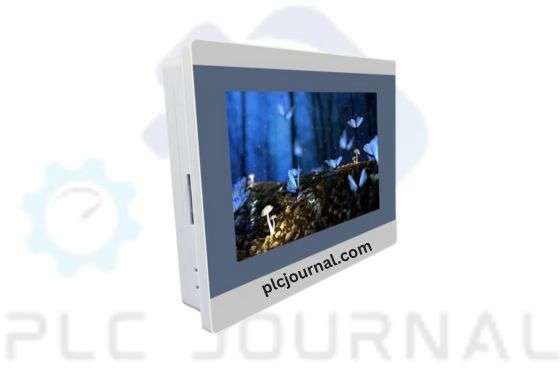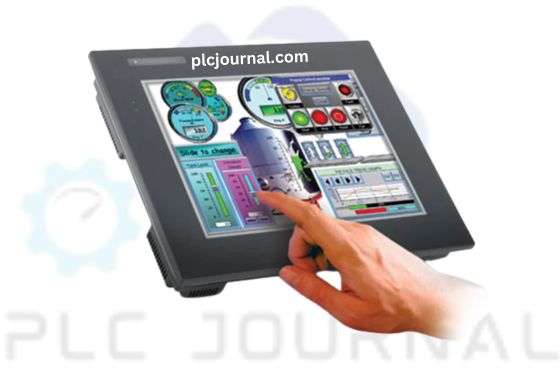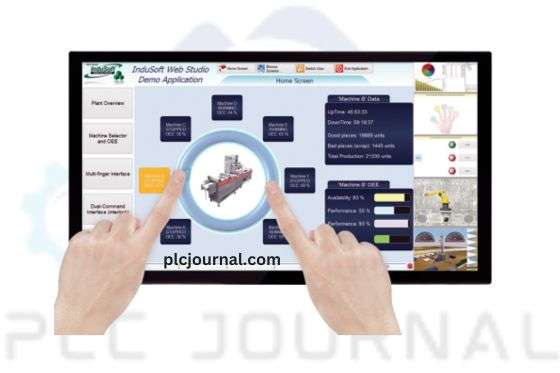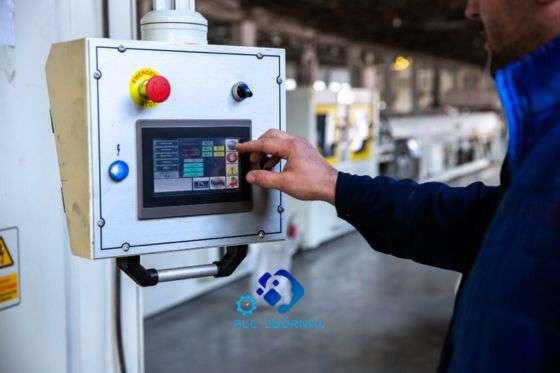What is HMI? Human-Machine Interface (HMI)
In today’s ever-evolving technological landscape, Human-Machine Interface (HMI), often abbreviated as HMI, plays a pivotal role in effectively bridging the gap between humans and machines. Moreover, it enables smooth communication and control between operators and automated systems. In this context, this article thoroughly delves into the world of HMI, carefully exploring its various facets, examining its wide range of applications, and finally highlighting the future trends that are progressively shaping its development.
Introduction – What is HMI? Human-Machine Interface
HMI is a term that encompasses the systems and technologies that enable humans to interact with machines and control their operations. In other words, it serves as the bridge between users and machines, thereby facilitating seamless communication, monitoring, and management of automated processes. In essence, it serves as the intermediary between a user and a machine, thereby facilitating seamless communication and efficient control. Through this interface, operators can monitor processes, adjust settings, and ensure that machines perform their intended tasks accurately and safely. HMIs have evolved significantly over the years, transforming the way we interact with technology.
Types of HMI
There are several types of HMI systems available today, each specifically designed to meet the unique requirements of different industries and applications. Consequently, selecting the appropriate HMI type ensures optimal performance, usability, and efficiency in a given operational context. To begin with, some of the most common types include: Basic HMIs, which provide simple control and monitoring functions; Advanced HMIs, offering complex data visualization and connectivity features; and Touchscreen HMIs, which enhance user experience through intuitive operation. Furthermore, specialized HMIs are designed for demanding industrial environments, ensuring reliability and precision in critical applications.
1. Traditional HMI

HMIs rely on physical interfaces such as buttons, switches, and dials. Traditionally, these systems have formed the foundation of industrial control, providing reliable, straightforward, and intuitive operation. Moreover, they continue to play a vital role in environments where simplicity and durability are essential. Moreover, they are commonly used in industrial settings and manufacturing plants where durability and tactile feedback are essential. As a result, such HMIs remain popular in environments that demand quick, hands-on control and high resistance to harsh conditions.
2. Graphical User Interfaces (GUI)

GUI-based HMIs use visual elements such as icons, menus, and touchscreens to enhance user interaction. They are prevalent in consumer electronics and automotive infotainment systems.
3. Voice-Activated HMI
Voice-activated HMIs leverage speech recognition technology to enable users to control devices through voice commands. Furthermore, they provide a hands-free and intuitive interaction method that enhances user convenience. Typically, these systems find applications in smart homes and automotive voice assistants, where quick and effortless communication between humans and machines is essential. Consequently, they contribute significantly to improving accessibility and user experience in modern automation environments.
Advanced HMI
Recent advancements in HMI technology have significantly led to more sophisticated and intuitive interfaces. As a result, users can interact with machines more efficiently, thereby improving control, monitoring, and overall system performance across various applications. As a result, these innovations have significantly improved how humans interact with machines. Today, advanced HMIs offer:
1. Multi-Touch Screens

Touchscreen HMIs allow users to interact with devices using gestures such as tapping, swiping, and pinching. Consequently, this makes them highly intuitive, efficient, and user-friendly for various applications.
2. Augmented Reality (AR) HMI
AR HMI, on the other hand, overlays digital information onto the user’s real-world view, thereby enhancing both perception and interaction with the environment in a more immersive and intuitive way.
3. Virtual Reality (VR) HMI
Similarly, VR HMIs completely immerse users in virtual environments, thus providing an entirely new level of interaction and control that is particularly common in gaming, training, and simulation applications.
Who Uses HMI?
HMI technology is employed across various industries and sectors, including:
- Manufacturing: HMIs control and monitor machinery on factory floors.
- Healthcare: In the medical field, many types of equipment incorporate HMIs to enable precise control and monitoring. Consequently, these interfaces help healthcare professionals operate devices accurately, ensure patient safety, and improve the efficiency of diagnostic and treatment processes.
- Automotive: In the automotive industry, vehicle infotainment systems and autonomous vehicles heavily rely on HMI interfaces. As a result, these interfaces enable drivers and passengers to interact seamlessly with navigation, entertainment, and safety systems, thereby enhancing convenience, safety, and overall driving experience.
- Home Automation: In modern smart homes, HMIs are widely utilized for controlling lighting, HVAC systems, and security. Consequently, they provide homeowners with convenient, centralized, and intuitive control over various household functions, enhancing comfort, energy efficiency, and safety.
Common Uses of HMI
Some common applications of HMI technology include:
1. Process Control
HMIs are crucial in industrial processes, where they monitor and control variables such as temperature, pressure, and flow rates.
2. Information Display
In the consumer electronics sector, HMIs effectively display vital information on screens, ranging from smartphones and tablets to smart thermostats and home automation devices. As a result, they enhance user experience by providing intuitive, accessible, and real-time control over everyday technology.
3. Automation
HMI technology plays a crucial role in driving automation, thereby enabling more efficient and precise control over machinery and systems. In addition, it facilitates real-time monitoring, reduces human error, and enhances overall operational productivity.
What is the Difference Between HMI and SCADA?
While HMI and SCADA (Supervisory Control and Data Acquisition) share similarities, they have distinct differences. HMI primarily focuses on the user interface, enabling interaction with a single machine or system, while SCADA extends its capabilities to monitor and control multiple interconnected systems in real-time.
Developing Trends in HMI Technology
The world of HMI is continually evolving, with several emerging trends shaping its future:
Touch Screens and Mobile Devices
The prevalence of touch screens and mobile devices has led to the development of more intuitive and portable HMIs. Consequently, these interfaces make technology more accessible to a broader audience, allowing users to interact with systems easily and efficiently. Moreover, the portability of such HMIs supports on-the-go monitoring and control, enhancing flexibility across various applications.
Remote Monitoring
With the rise of IoT (Internet of Things), remote monitoring through HMI interfaces has become increasingly widespread. As a result, users can now monitor and control devices from virtually anywhere, thereby enhancing both convenience and operational efficiency. Furthermore, this connectivity allows for real-time data analysis and proactive system management, significantly improving overall productivity.
Peering into the Future of HMI
As technology advances, we can expect HMI to become even more integrated into our daily lives. With innovations such as brain-computer interfaces and AI-driven HMIs on the horizon, the possibilities for human-machine interaction are virtually limitless. Consequently, the future of HMI promises more natural, intuitive, and seamless interactions between humans and machines, ultimately transforming how we monitor, control, and engage with automated systems across various industries.
Conclusion – What is HMI? Human-Machine Interface
In conclusion, HMI, or Human-Machine Interface, serves as the vital link between humans and technology. Its diverse applications, from industrial automation to consumer electronics, make it an integral part of our daily lives. As technology continues to advance, we can anticipate even more intuitive and immersive HMI experiences, revolutionizing the way we interact with machines.
Frequently Asked Questions: What is HMI? Human-Machine Interface (HMI)
HMI is connected to PLC using communication protocols like Ethernet, serial communication, or fieldbus protocols.
Hardware-Based HMI (physical devices) and Software-Based HMI (software applications).
PLC (Programmable Logic Controller) controls machines and processes, while SCADA (Supervisory Control and Data Acquisition) monitors and manages large-scale systems.
HMI is the interface between humans and machines, displaying real-time data, enabling user interaction, and sending control commands to industrial systems.
Components include a display screen, input devices, a processor, communication ports, software, storage, and a power supply.
Technical Guides
What Is a Programmable Logic Controller (PLC)? Full Explanation
What is HMI? Human-Machine Interface (HMI)-Full Explanation
What is a Variable Frequency Drive?-It’s complete guidelines
What Is a Servo drive and How Does it Work? It’s complete guidelines
Manual PDF
[PDF] Delta PLC DVP-ES2/EX2/SS2/SA2/SX2/SE&TP Operation Manual Free Download
Delta HMI-DOPSoft User Manual Free Download [PDF]
Cable Making
[DIY-Cable] PLC/HMI-Panasonic Connecting PC
[DIY-Cable] PLC/HMI-Keyence Connecting PC
[DIY-Cable] S7-200 Siemens Connecting PC
[DIY-Cable] Mitsubishi PLC Programming Cable SC-09 for FX-Series
[DIY-Cable] PLC Delta Programming Cable DVPACAB230
[DIY-Cable] PLC OMRON Programing Cable for CJ/CS/CQ-Series
[DIY-Cable] PLC “LS/LG” Programing Cable
[DIY-Cable] PLC “Fatek/Facon” Programing Cable
[DIY-Cable] PLC “Vigor” Programing Cable
[DIY-Cable] HMI “Fuji/Hakko” Programing Cable
[DIY-Cable] “HMI Omron NT-Series” Programing Cable
[DIY-Cable] HMI Keyence “VT3-W4 Series” Cable Connecting To PLC
[PDF] HMI-Weintek Connection PLC Guide







The content on this site is not only insightful but also presented in a visually appealing manner. Kudos to the team for making learning such a delightful experience.